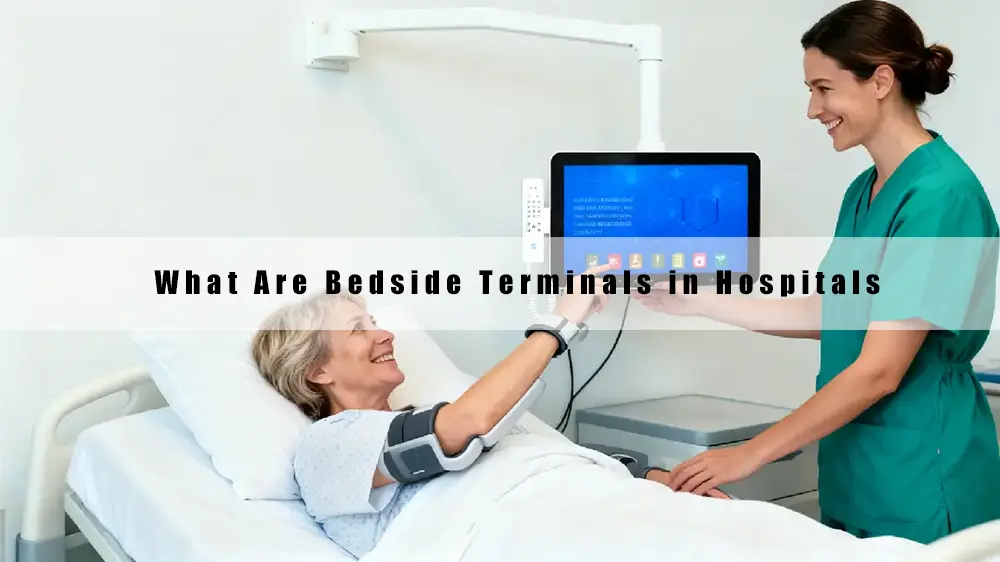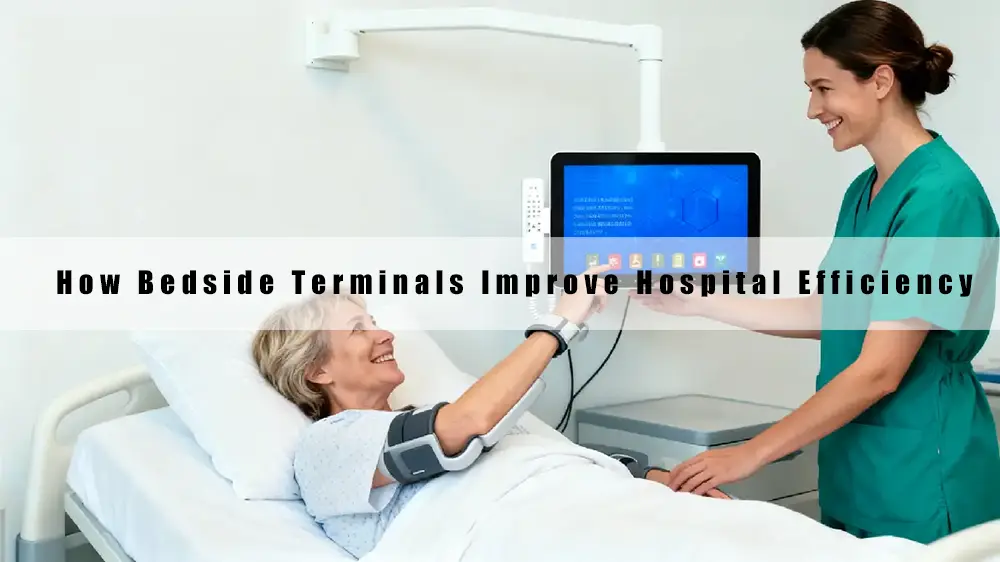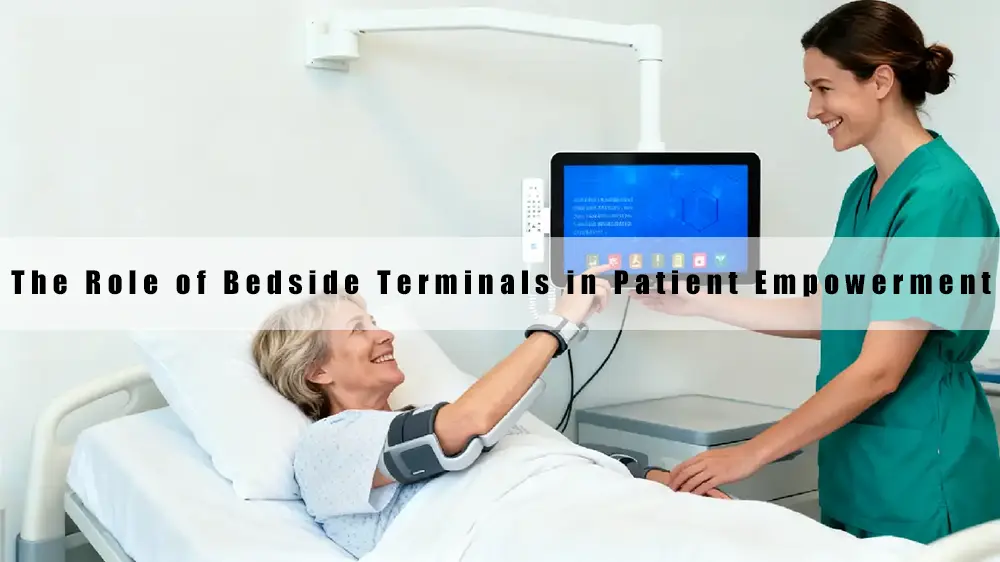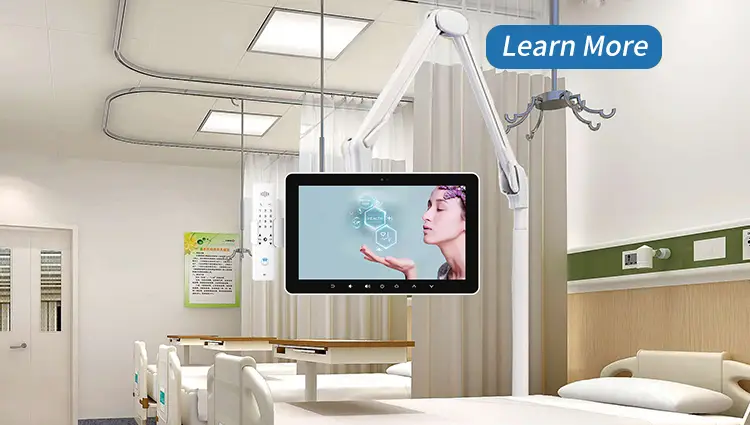Hospitals around the world are embracing digital transformation—and at the heart of this evolution lies a quiet revolution: bedside terminals. These sleek, multifunctional devices are more than just hospital entertainment systems; they’re a bridge between patients, caregivers, and hospital information systems.
In an age where efficiency, accuracy, and patient satisfaction define healthcare excellence, bedside terminals in hospitals are emerging as indispensable tools. They streamline clinical workflows, empower patients with self-service capabilities, and elevate the overall care experience.
So, what exactly makes bedside terminals so valuable in 2025’s healthcare landscape? Let’s explore how hospitals are leveraging this technology to redefine patient-centered care.

1. What Are Bedside Terminals in Hospitals?
A bedside terminal is a smart device—typically a touchscreen tablet or mounted display—installed at a patient’s bedside. These terminals integrate hospital information systems (HIS), electronic medical records (EMR), and entertainment platforms, allowing both patients and medical staff to access vital functions in one place.
Core Functions Include:
- Patient information access: Real-time viewing of medical charts and lab results.
- Communication tools: Secure messaging between patients, nurses, and doctors.
- Entertainment options: Internet browsing, TV, movies, and social media access.
- Meal ordering and service requests: Streamlined non-clinical operations.
- Staff utilities: Input and retrieval of EMR data, medication management, and workflow optimization.
Bedside terminals bridge comfort and care—reducing administrative burden while improving the patient’s sense of engagement and control.

2. Why Are Hospitals Investing in Bedside Terminals?
The shift toward smart bedside technology isn’t just a trend—it’s a strategic necessity. Here’s why healthcare institutions are prioritizing bedside terminals in 2025:
a. Enhancing Patient Experience
A patient-centric approach drives hospital reputation. Bedside terminals allow patients to:
- Watch educational videos about their treatment.
- Adjust room lighting, temperature, and curtains independently.
- Communicate with nurses without delay.
- Access entertainment options, reducing stress and anxiety.
According to a 2024 Healthcare IT News survey, hospitals using digital bedside systems reported a 27% increase in patient satisfaction scores.
b. Streamlining Clinical Workflows
Medical staff benefit tremendously from bedside terminals:
- Doctors can review records and chart notes instantly.
- Nurses can input vitals or medication updates without leaving the bedside.
- Alerts and notifications reduce response times in emergencies.
The result? Improved accuracy, time efficiency, and better collaboration across departments.
c. Reducing Operational Costs
Automation through bedside systems reduces manual paperwork, phone calls, and repetitive tasks. Hospitals that have integrated bedside terminals report an average cost reduction of 18% in administrative workloads.

3. Key Features Every Hospital Bedside Terminal Should Have
To deliver real value, bedside terminals must balance performance, usability, and integration. Below are essential features that define a top-tier hospital bedside terminal in 2025:
| Feature | Purpose | Benefit |
|---|---|---|
| Touchscreen interface | Easy interaction for all age groups | Enhances usability and accessibility |
| Anti-bacterial coating | Infection control | Maintains hygiene in clinical environments |
| Integrated EMR access | Patient data management | Reduces human errors and data silos |
| VoIP and video calling | Communication between patients and staff | Improves response times |
| Nurse call integration | Streamlines assistance requests | Enhances patient safety |
| Entertainment suite | TV, movies, and music | Improves emotional well-being |
| Modular OS (Android/Linux/Windows) | Flexibility for hospital systems | Ensures compatibility and customization |
These terminals can also support external medical peripherals—blood pressure monitors, thermometers, and glucose meters—further boosting functionality.

4. How Bedside Terminals Improve Hospital Efficiency
Bedside terminals optimize both clinical and non-clinical operations through data-driven connectivity. Let’s break down the operational impact:
a. Real-Time Data Synchronization
Bedside devices integrate directly with HIS and EMR platforms, ensuring doctors and nurses always have the latest data at hand. This eliminates delays and miscommunication.
b. Streamlined Communication
Instead of traditional nurse calls, patients can specify requests through touchscreen menus—“medication reminder,” “meal delivery,” or “cleaning service.” The right department is notified instantly, cutting response times by up to 40%.
c. Paperless Administration
Hospitals can digitize forms, feedback, and consent documentation. This supports sustainability goals and reduces manual processing errors.
d. Staff Efficiency Gains
A 2023 Frost & Sullivan report found that hospitals deploying bedside terminals saw a 22% improvement in staff efficiency, freeing more time for direct patient care.
5. The Role of Bedside Terminals in Patient Empowerment
Healthcare is moving toward a model of shared decision-making. Bedside terminals enable this shift by giving patients control over their information and environment.
Empowerment Through Information:
Patients can:
- Review lab results and medication schedules.
- Watch instructional videos about procedures.
- Track recovery progress in real time.
Empowered patients feel more confident, leading to higher recovery compliance rates and reduced readmissions.
Emotional Comfort and Mental Well-Being
Isolation can be detrimental to recovery. Through video calls and entertainment features, bedside terminals keep patients emotionally connected—particularly valuable in long-term care or pediatric wards.
6. Frequently Asked Questions (FAQ)
Q1: Are bedside terminals secure for patient data?
Yes. Modern bedside terminals comply with strict standards such as HIPAA, GDPR, and ISO/IEC 27001. Hospitals use encrypted communication and role-based access control to ensure patient data remains protected.
Q2: Can bedside terminals be integrated with existing hospital systems?
Absolutely. Most advanced bedside terminals support API-based integration with HIS, PACS, EMR, and billing systems, ensuring smooth interoperability.
Q3: What operating systems do they use?
Manufacturers typically offer Android, Linux, or Windows-based options. The choice depends on the hospital’s IT infrastructure and compatibility needs.
Q4: Are bedside terminals cost-effective?
While the initial investment can be substantial, hospitals often see ROI within 12–18 months due to efficiency gains and reduced administrative workloads.
Q5: How are these devices cleaned or maintained?
Terminals are designed for medical environments—sealed, waterproof, and equipped with anti-bacterial surfaces. They can withstand frequent disinfectant cleaning without damage.
7. Future Trends: The Smart Patient Room of 2030
The next generation of bedside terminals will go beyond screens—they’ll be AI-driven care assistants.
Predicted Developments Include:
- AI-powered voice interaction: Enabling hands-free control and health guidance.
- Predictive analytics: Monitoring patient vitals and alerting staff of anomalies.
- IoT integration: Connecting medical devices, beds, and room sensors.
- Telemedicine functions: Allowing remote consultations within the hospital network.
These innovations will help hospitals evolve into fully connected ecosystems, improving both patient satisfaction and operational intelligence.
8. How to Choose the Right Bedside Terminal for Your Hospital
When selecting a bedside terminal, hospital administrators should evaluate:
- System Compatibility: Does it integrate with your EMR and nurse call systems?
- Hardware Durability: Is it water-resistant, easy to clean, and medical-grade certified?
- Software Flexibility: Can it be updated remotely and customized to your workflow?
- Vendor Support: Does the supplier provide long-term maintenance and updates?
- Cost-to-Benefit Ratio: Consider both upfront costs and long-term efficiency gains.
A smart investment today ensures a seamless, connected, and patient-friendly hospital environment tomorrow.
Conclusion
In today’s competitive healthcare landscape, hospitals can’t afford inefficiencies or outdated communication systems. Bedside terminals are no longer optional—they are strategic assets driving smarter care, better communication, and higher patient satisfaction.
By empowering patients, reducing workloads, and integrating seamlessly with hospital IT systems, bedside terminals redefine the meaning of modern care. As digital health continues to evolve, one thing is certain—the bedside terminal is the cornerstone of intelligent, patient-centered hospitals in 2025 and beyond.

